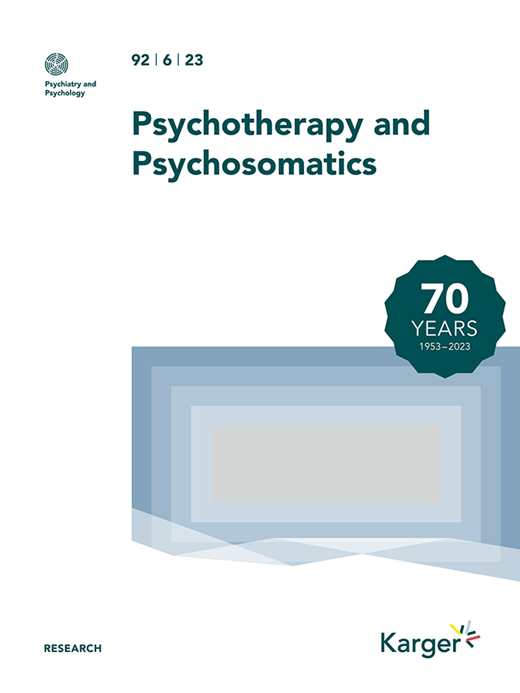基于推理的认知行为疗法与认知行为疗法治疗强迫症:多点随机对照非劣效性试验》(Multisite Randomized Controlled Non-Inferiority Trial)。
IF 17.4
1区 医学
Q1 PSYCHIATRY
引用次数: 0
摘要
简介虽然认知行为疗法(CBT)能有效治疗强迫症(OCD),但许多患者拒绝接受 CBT 或过早放弃,部分原因是对暴露和反应预防(ERP)练习感到焦虑。基于推理的认知行为疗法(I-CBT)侧重于纠正扭曲的推理思维模式,增强基于现实的推理能力,并通过针对潜在的功能障碍推理来解决强迫症疑虑,但不包含ERP成分。我们假设 I-CBT 不会劣于 CBT。此外,我们还假设 I-CBT 比 CBT 更易忍受。方法 197 名参与者被随机分配到 20 个疗程的 CBT 或 I-CBT,并在基线、治疗后、6 个月和 12 个月的随访中接受评估。主要结果是使用耶鲁-布朗强迫症量表(Y-BOCS;非劣效差:2 分)测量的强迫症症状严重程度。次要结果是治疗耐受性,采用治疗可接受性/依从性量表(TAAS)进行评估。采用线性混合效应模型评估主要结果的非劣效性和次要结果的优效性。在任何评估点,Y-BOCS 均未发现具有统计学意义的组间差异,但置信区间超过了非劣效性阈值,因此结果尚无定论。虽然 CBT 和 I-CBT 对强迫症都有效,但就强迫症症状的严重程度而言,I-CBT 是否不劣于 CBT 仍无定论。然而,I-CBT具有更好的耐受性,值得考虑作为强迫症的替代治疗方法。本文章由计算机程序翻译,如有差异,请以英文原文为准。
Inference-Based Cognitive Behavioral Therapy versus Cognitive Behavioral Therapy for Obsessive-Compulsive Disorder: A Multisite Randomized Controlled Non-Inferiority Trial.
INTRODUCTION
Although cognitive behavioral therapy (CBT) effectively treats obsessive-compulsive disorder (OCD), many patients refuse CBT or drop out prematurely, partly because of anxiety regarding exposure and response prevention (ERP) exercises. Inference-based cognitive behavioral therapy (I-CBT) focuses on correcting distorted inferential thinking patterns, enhancing reality-based reasoning, and addressing obsessional doubt by targeting underlying dysfunctional reasoning, without incorporating an ERP component. We hypothesized that I-CBT would be non-inferior to CBT. Additionally, we hypothesized that I-CBT would be more tolerable than CBT.
METHODS
197 participants were randomly assigned to 20 sessions CBT or I-CBT and assessed at baseline, posttreatment, and 6 and 12 months' follow-up. The primary outcome was OCD symptom severity measured using the Yale-Brown Obsessive-Compulsive Scale (Y-BOCS; non-inferiority margin: 2 points). The secondary outcome, treatment tolerability, was assessed using the Treatment Acceptability/Adherence Scale (TAAS). A linear mixed-effects model was used to assess the non-inferiority of the primary outcome and superiority of secondary outcomes.
RESULTS
Statistically significant within-group improvements in the primary and secondary outcomes were observed in both treatments. No statistically significant between-group differences in Y-BOCS were found at any assessment point, but the confidence intervals exceeded the non-inferiority threshold, making the results inconclusive. The estimated mean posttreatment TAAS score was significantly higher in the I-CBT group than in the CBT group.
CONCLUSION
While both CBT and I-CBT are effective for OCD, whether I-CBT is non-inferior to CBT in terms of OCD symptom severity remains inconclusive. Nevertheless, I-CBT offers better tolerability and warrants consideration as an alternative treatment for OCD.
求助全文
通过发布文献求助,成功后即可免费获取论文全文。
去求助
来源期刊

Psychotherapy and Psychosomatics
医学-精神病学
CiteScore
29.40
自引率
6.10%
发文量
46
期刊介绍:
Psychotherapy and Psychosomatics is a reputable journal that has been published since 1953. Over the years, it has gained recognition for its independence, originality, and methodological rigor. The journal has been at the forefront of research in psychosomatic medicine, psychotherapy research, and psychopharmacology, and has contributed to the development of new lines of research in these areas. It is now ranked among the world's most cited journals in the field.
As the official journal of the International College of Psychosomatic Medicine and the World Federation for Psychotherapy, Psychotherapy and Psychosomatics serves as a platform for discussing current and controversial issues and showcasing innovations in assessment and treatment. It offers a unique forum for cutting-edge thinking at the intersection of medical and behavioral sciences, catering to both practicing clinicians and researchers.
The journal is indexed in various databases and platforms such as PubMed, MEDLINE, Web of Science, Science Citation Index, Social Sciences Citation Index, Science Citation Index Expanded, BIOSIS Previews, Google Scholar, Academic Search, and Health Research Premium Collection, among others.
 求助内容:
求助内容: 应助结果提醒方式:
应助结果提醒方式:


